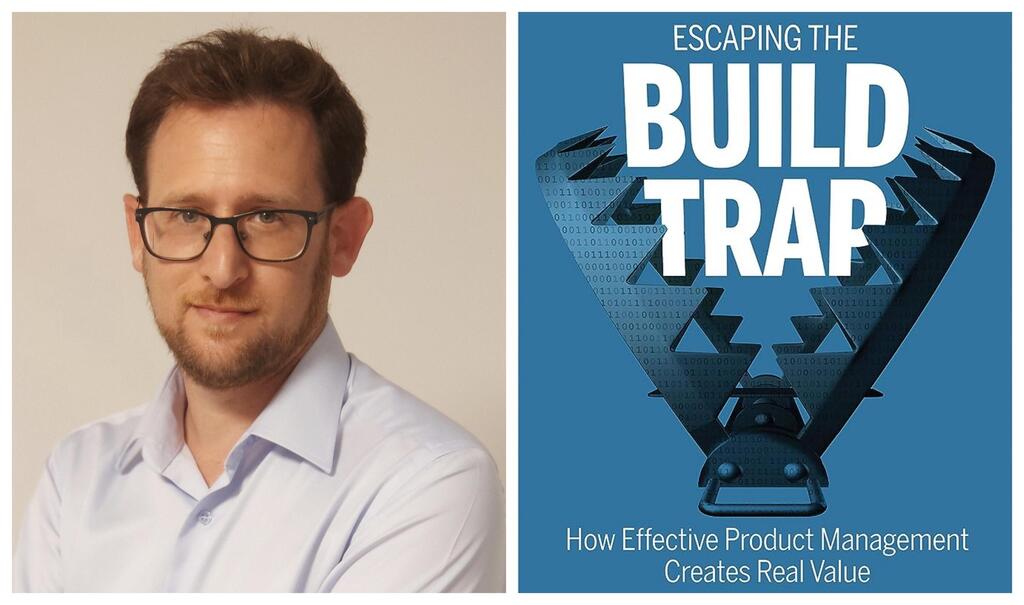Gil Marx is the VP Product at Trullion, an AI-powered platform that automates manual work for finance and audit teams. He has joined CTech to share a review of "Escaping the Build Trap" by Melissa Perri
Title: "Escaping the Build Trap" Author: Melissa Perri Format: Book Where: Home
The "build trap" is defined by Melissa Perri as a common pitfall that software development organizations can fall into. It occurs when the primary focus of the organization becomes building and releasing more features without a clear strategic direction or a deep understanding of customer needs.
"Escaping the Build Trap" is a transformative book that addresses the common challenges faced by software development organizations. The book emphasizes the importance of shifting from a feature-centric mindset to a customer-centric and outcome-driven approach. By understanding user needs and continuously validating assumptions, organizations can create products that deliver real value.
The author introduces the "Continuous Product" framework, advocating for seamless integration of product discovery, validation, delivery, and monitoring. This fosters cross-functional collaboration and empowers teams to take ownership of the entire product lifecycle. The book also encourages a culture of learning from failures and promoting experimentation to drive innovation.
By breaking free from the build trap and aligning product development efforts with strategic goals, "Escaping the Build Trap" provides a roadmap for creating successful and impactful products.
Important themes:
"Escaping the Build Trap" presents a comprehensive set of themes that promote a strategic and customer-focused approach to product development. By embracing these principles, organizations can break free from the build trap and deliver products that meet user needs, drive business success, and stay ahead in today's competitive market:
Customer-Centricity: One of the central themes of the book is the importance of being customer-centric. Perri emphasizes the significance of understanding the needs, pain points, and aspirations of users. By deeply empathizing with customers and involving them throughout the product development process, organizations can create products that truly address real problems and deliver genuine value.
Outcome-Driven Approach: The book encourages a shift from a feature-centric mindset to an outcome-driven approach. Rather than focusing solely on developing and delivering more features, the emphasis should be on achieving specific outcomes and business goals.
Related articles:
Continuous Product Framework: The Continuous Product framework is a key concept introduced in the book. It advocates for integrating product discovery, validation, delivery, and monitoring into a seamless process. This approach promotes cross-functional collaboration, allowing teams to work together towards a shared vision and ensuring that the entire product development lifecycle is well-coordinated.
Culture of Learning and Experimentation: Embracing failure as an opportunity for learning and growth is another essential theme in the book. Organizations that foster a culture of experimentation and learning are better equipped to adapt quickly and stay ahead in the market. This mindset shift encourages teams to take calculated risks, validate assumptions, and iterate on products to continuously improve and innovate.
Strategic Alignment: The book underscores the importance of aligning product development efforts with the overall business strategy. By prioritizing initiatives that support the company's strategic goals and long-term vision, product managers can ensure that their work contributes to the organization's success.
Avoiding Wasteful Efforts: Building on the outcome-driven approach, the book cautions against wasting resources on low-priority or low-impact features. Instead, product teams should focus on initiatives that deliver real value to users and the business, avoiding unnecessary features that do not align with strategic objectives.
Empowering Product Teams: The book encourages product managers and leaders to empower their teams to make decisions and take ownership of the product development process, for example - by creating an environment where teams are trusted and have the autonomy to experiment and innovate.
What I’ve learned:
While the book covers themes which most are pretty common in product-oriented companies, it did help me clarify these important values:
-
Focus on MVP, down to the bone. I must admit that in the past I’ve launched features thinking they are required for an MVP when in fact, additional layers could have been peeled off (or left out in the first place).
-
Always engage with clients. While this was always a given, after reading the book I’ve doubled down on the efforts with outbound engagement. I’m proud to say that Trullion identifies being customer driven as one of its core objectives for every aspect of the company.
-
Fail fast. It can be helpful to set boundaries and budget for experimentation, as in "you can only spend $100K on this experiment (all-in), after which let's review what we've learned and we'll think about investing more."
-
A product leader in a product suite organization, should always go back to the fundamentals and continuously ask themself questions such as:
-
How do all of our products work as a system to provide value to our customers?
-
What unique value does each of the product lines offer that makes this a compelling platform?
-
What overall values and guidelines should we consider when deciding on new product solutions?
-
What should we stop doing or building because it does not serve this vision?
As mentioned, the above values and themes were always top of mind, but this book definitely refined some key points which I’ve applied in Trullion. Trullion’s Product Managers carry a strategic role (not just a tactical one) and own the entire lifecycle of the product, end-to-end, helping drive their products on a business level.
Related articles:
Critiques:
While "Escaping the Build Trap" has received widespread praise for its valuable insights and strategic approach to product development, I do have some criticism:
Limited Implementation Guidance: The book could provide more specific and practical guidance on how to implement the Continuous Product framework in different organizational contexts. Readers might benefit from more detailed case studies or examples to understand how to apply these ideas in their own companies.
Overlooking Constraints: The book might not adequately address the challenges and constraints that certain organizations face. Implementing the principles in resource-constrained environments or highly regulated industries could require additional considerations and adaptation, which may not be fully explored in the book.
Who should read this book:
I recommend this book to everyone who wants to learn the best practices for the Product Manager role. Product leaders will also enjoy it as it helps refine some day-to-day issues we struggle with.
As with any book, its value may vary depending on the reader's context and specific needs, but it undeniably provides a thought-provoking foundation for achieving successful product development and innovation.
CTech's Book Review: Understanding the "Continuous Product" Framework - CTech
Read More












